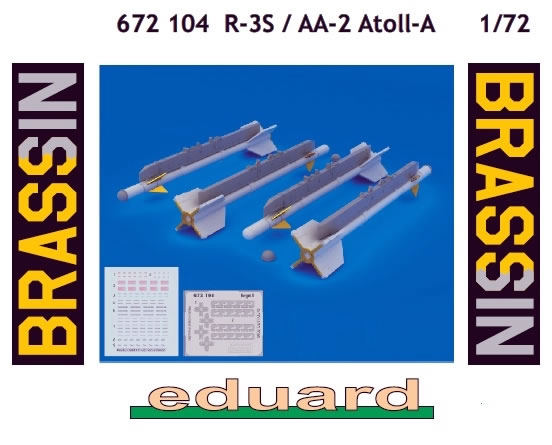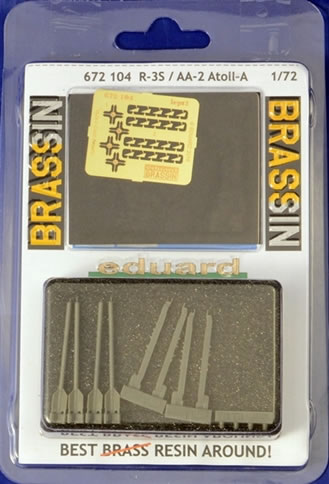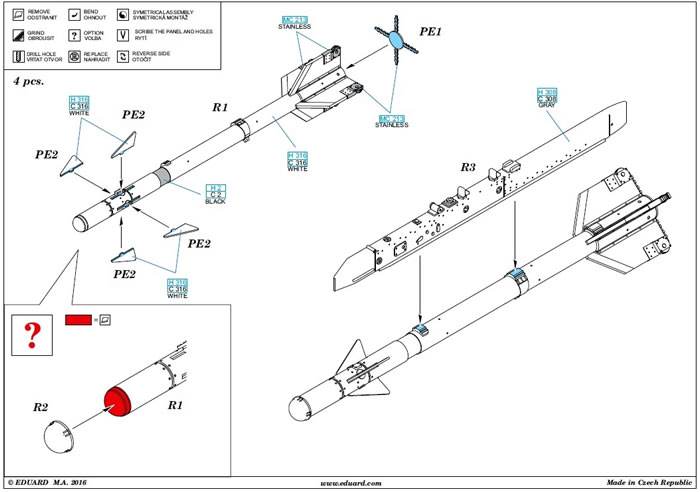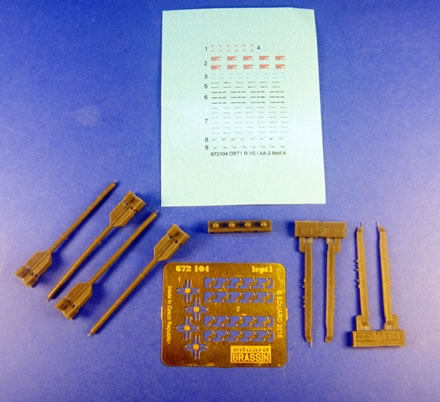R-3S / AA-2 Atoll-A

Eduard BRASSIN, 1/72 scale
S u m m a r y : |
Catalogue Number: |
Eduard BRASSIN Item No. 672 104 - R-3S / AA-2 Atoll-A |
Scale: |
1/72 |
Contents & Media |
12 resin parts, a PE fret of twenty-four pieces, and decals. |
Price: |
Available online from these stockists:
|
Review Type: |
First Look. |
Advantages: |
Superb quality, launch rails included, and spare PE fins. |
Disadvantages: |
None noted. |
Conclusions: |
Eduard Brassin’s Atoll-’s are very nicely rendered, and represent an excellent complement for many 1960’s & 70’s fighter subjects from the Soviet-bloc and unaligned nations like India. The inclusion of launch rails is a nice bonus.
Definitely recommended. |
Reviewed by Mark Davies

Eduard's 1/72 R-3S / AA-2 Atoll-A Missiles are available online from Squadron.com
During the Second Taiwan Strait Crisis in 1958, the Republic of China's (Taiwan) F-86 Sabres faced the much higher performance, mainland Chinese PLAAF MiG-17s. The MiGs had speed, maneuverability and altitude advantages over the F-86 Sabres, allowing them to engage only when they desired, normally at advantageous times. In response, the US Navy rushed to modify 100 of the ROC's Sabres to fit the newly introduced AIM-9 Sidewinder missile, the latest model being the "B" version. These were introduced into combat for the first time on 24 September 1958, when a group of MiG-17s cruised past a flight of Sabres, only to find themselves under attack by missile fire. This was the first instance of guided missiles being used in air-to-air combat.
On 28 September 1958, a similar engagement resulted in one of the missiles becoming lodged in a MiG-17 without exploding, allowing it to be removed after landing. The Soviets later became aware that the Chinese had at least one Sidewinder, and after some wrangling, were able to convince the Chinese to send them one of the captured missiles. Gennadiy Sokolovskiy, later chief engineer at the Vympel team, said that "the Sidewinder missile was to us a university offering a course in missile construction technology which has upgraded our engineering education and updated our approach to production of future missiles.
The Sidewinder was reverse engineered by the Soviet Union as the K-13 (also called R-3 or Object 300) and entered limited service in 1960. This was followed by the improved K-13A (R-3S, Object 310), which entered service in 1962. The R-3S was the first version to enter widespread production, in spite of a very long seeker settling time on the order of 22 seconds (as opposed to 11 for the original).
The R-3S was seen by the West in 1961 and given the NATO reporting name AA-2A 'Atoll'. Minimum engagement range for the R-3S is about one kilometre. All K-13 variants are physically similar to Sidewinder, sharing the 5 inch (127 mm) diameter. Subsequent examination of AA-2 missiles captured by NATO forces showed that parts from an AIM-9 could be interfaced with parts from an AA-2 and either combination would still work.
Source: Wikepedia
If “The One True Scale” has a weakness, it is that the missiles supplied with 1/72 kits often suffer from over-scale fins due to the limitations of injection moulding, as well as sometimes having simplified detail in other areas. The usual solution for the former issue is to use PE fins, whilst better overall detail can be obtained by casting in resin. (Although, I have seen 3D-printed missiles with very fine fins, and there is of course the laborious option of scratch building if you have the skill and patience.)
Predictably, Eduard Brassin uses resin and photo-etched brass to provide us with four examples of the early model Atoll-A, complete with launch rails. This will be most welcome to modellers of 1960’s & 70’s fighters, as Atoll-A’s seem a bit rare from aftermarket sources.
The four missiles come attractively packaged in a blister pack with sponge cushioning.

Very clear instructions are included, downloadable as a PDF from Eduard’s website, with colour call-outs cross-referenced to the Gunze Aqueous and Mr Color paint ranges. A small sheet of decals provides the missile markings.

The quality of casting is excellent, with the pour subs attached to the tail fins. Separate protective covers for the seeker-heads are supplied in resin, but you will have to cut the seeker-heads from the missile fuselages if you plan to use these. The forward fins are made of PE; sixteen being required to complete four missiles, although twenty are supplied, so you have four spare. Four PE rings representing the rocket motor exhausts with cross braces that fit to the fins’ trailing edges are also included.

Painted and decaled, these Atolls should be an excellent addition to any suitable model; they are sure to be a vast improvement over any injected kit items.
Eduard offers a very similar 1/48 scale set of four Atoll-A’s (Brassin 648125), but with separate clear seeker-heads, for US$14.95.
Eduard Brassin’s Atoll-A’s are very nicely rendered, and represent an excellent complement for many 1960’s & 70’s fighter subjects from the Soviet-bloc and unaligned nations like India. The inclusion of launch rails is a nice bonus.
Definitely recommended.
Thanks to Eduard for the samples and images.
Review Text & Images Copyright © 2016 by Mark Davies
Page Created 12 September,, 2016
Last updated
12 September, 2016
Back to HyperScale Main Page
Back to Reviews Page

|
